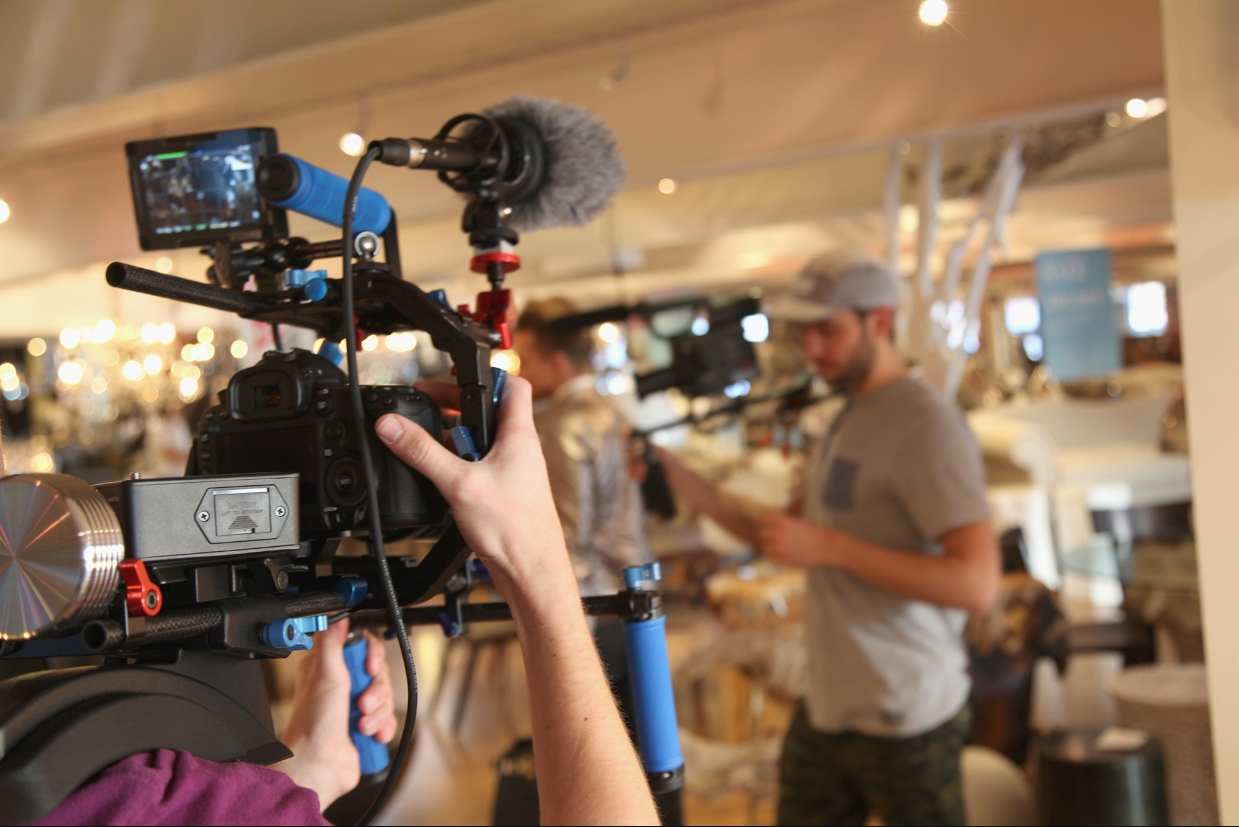Sometimes, it’s a friend personally telling you what the latest is. It could also be a movie star narrating an exciting tale onscreen. No matter what form a good story takes, it’s always going to be something that stops you on your tracks, makes you drop everything, and forces you to pay close attention.
That’s how powerful stories are, and that’s a kind of power your brand can fully take advantage of.
The Power of Storytelling
Now, just because a story is told does not necessarily mean your audience will automatically start engaging with your brand. It’s not magic. There’s a science behind it.
Humans are highly social creatures. Empathy is a strong driving force for us, especially when it comes to our decision making. This vital piece of information is going to make all the difference between a bland and boring business video and a highly-engaging, impactful one.
Emotional stimulation triggers empathy in the human brain. The more emotionally compelling a story is, the more likely the brain will remember it.
Of course, just as humans are social creatures, we are highly visual as well. So just imagine what kind of an impact you can have if you combine storytelling with video marketing.
What Videos are Capable Of
How much video content do you see on your social media newsfeed in a single day?
For sure, you see so much of them that you’ve already lost count. You see, video content is the future of marketing. Here are a few numbers that prove this fact:
- Consumers watch an average of 1.5 hours of video each day.
- 15% of respondents in a HubSpot survey say that they watch over 3 hours of video each day.
- 72% of consumers would rather learn about a product or service through video.
- 81% of businesses are already using video marketing.
- 97% of marketers admit that users understand their product or service better because of their video marketing efforts.
- 76% of businesses admit that video marketing has helped them increase sales.
Can you imagine how much impact it would have on your business if you start taking video marketing more seriously?
It doesn’t even matter what kind of audience you have. The simple truth is that you can deliver more information in a few seconds of video than you can in written content. McQuivey Forrester says that a minute of video is worth 1.8 million words.
Retention is also a very important thing for marketers. You want your message to have long-lasting impact. The moment they walk away from your content, they have to at least remember details from it a few days from now. That’s how marketing is supposed to work, after all.
Well, here are more numbers you should see in terms of retention. Note that these numbers show how much information is retained 3 days after content is consumed:
- Consumers retain 10% of information from text content.
- They retain 65% of information if the text is paired with relevant images.
- 95% of information is retained if the content is delivered in video form.
This is the power of video marketing.
Telling Powerful Brand Stories Through Videos
You’ve seen the numbers. This time, let’s figure out how to integrate the power of storytelling into your video marketing approach.
These tips should help you create the kind of business videos that will stick to audiences over a longer period of time.
1. Dig into your “why”
Why are you doing this? It can’t just be for the profit. There has to be a deeper reason than that. And that deeper reason is just the thing that connects you to your audiences.
To find out what your why is, you’ll have to go back to why your brand started in the first place. Was it to create a more affordable option for people in your target market, or was it to create a more exclusive group that only a few can enter? Was it to address a specific social advocacy?
From there, look at where you now stand and see if that purpose has changed through the years.
By figuring out your why, you can create a framework for your video that’s uniquely yours. It has to reflect each and every value that you have as a brand. If you see your brand as having a fun, collaborative nature, then steer clear of serious, overly-corporate scenes. This allows your video to attract the right kind of crowd.
Here’s Steve Jobs talking about Apple’s brand purpose.
2. Stick to the right length.
We’re sure you have so much that you want to say. But you’re trying to create a high-impact business video, not a documentary.
Video length actually depends on what platform you’re planning to use.
-
- Instagram videos that average 30 seconds receive the most number of comments.
- Twitter videos that make it as #VideoOfTheDay average 43 seconds.
- Facebook videos that average 1 minute in length get the most engagement.
- YouTube videos averaging 2 minutes in length see the best engagement.
Why are the average lengths different?
Because it’s a different audience for each unique platform. On Facebook, for example, every age range between 18 and 65 is well-represented. On SnapChat, however, 45% of its users are aged 18-24.
What about other platforms outside the social media spectrum?
Well, you’re still going after the same audience, right? So whether they’re viewing the video on a social media page or on your own website, their attention span will still be the same.
Besides, more people are on the go now, thus the huge growth in the mobile sector. You’d have to expect right away that people do not have all the time in the world. And even if they do, they know how much content is out there. You’d have to use up as little of their time as possible to deliver your content before they decide to jump to something else.
Here’s a video that says everything that needs to be said in less than 2 minutes.
3. Make every second count.
Even for 2-hour movies, you’ll notice that every single period of dead air highly impacts its overall rating. What more if you’re presenting a video that only lasts for a minute or less?
Did you know that Facebook users on mobile only spend an average of 1.7 seconds on a piece of content?
This means that’s your average timeframe to catch your audience’s attention and convince them to stay for the rest of the video.
1.7 seconds? Is that enough?
DEFINITELY!
Just because you hear “storytelling” does not mean you need a complicated intro and a detailed outro. Making every second count means getting right into the meat of the message the exact second your video starts.
You can start with a compelling line, or a question that will make the audience pause and think. It’s all up to you! Make your first frame high-impact, then follow it up with frame after frame of even more highly-engaging content.
Here’s Burt’s Bees brand video, and it proves that 30 seconds is more than enough to make people realize how much they support your advocacy:
4. Use emotional triggers
For sure, some of you will immediately imagine a lot of drama when they hear the word “emotional”. But there are so many emotions that trigger empathy in audiences, that you don’t really have to plan for a dramatic scene just yet.
Happiness or joy, of course, is something that easily pulls people in. They say that in using images for content, a smiling face usually draws more people in compared to other kinds of visual content. So imagine how much more impact a smile or laughter can have if shown in video form.
Most marketers would prefer using positive emotions, and that’s understandable. After all, you don’t really want to cast a lot of negative light, especially when it comes to your brand.
But you also have to understand that negative emotions are not so bad, after all.
Fear, for example, is one common emotion that triggers a response among audiences. The same thing goes for anger and sadness.
Think about your story. Was the very thing that triggered the conception of your brand related to any of these emotions? Was there fear involved, causing you to provide security and assurance? Are you trying to offer justice for something that has stirred anger?
Use all those in sharing your story. These would build that trust that you need between you and your target market. Showcasing these emotions tell your audience, “Yes, we know exactly what you’re going through.”
5. Don’t sell
This is your brand story – remember that. Your goal here is to show people who you are and what you do. It’s not about selling or promoting. It’s a basic getting-to-know-you activity that acquaintances often start with.
This is why you have to use every second of your video to share your story – period. Share what your mission and vision is. Let them know what your core values are. Give them a behind-the-scenes look at what you do everyday.
You can make it wacky, or you can make it serious. You can keep it straightforward, or you can take a creative way through the entire thing. It’s up to you, as long as you don’t make it salesy.
6. Make the most out of technology
If you find that creating an amazing business video on your brand story is tough, just imagine how much harder it was for marketers years ago. Sure, video was not as hyped up as it is now, but they still used videos for promotion, and whatever tech we now have, the marketers of the past did not enjoy.
So count your blessings and enjoy the fact that you have a long list of tech available for your brand video.
Considering everything you can use, where do you start?
Of course, it would be great if you consider something out of the box. How about creating a 3D video? Have you tried stop motion? Would you know anyone who can create amazing animation?
There are so many options!
Also, keep in mind that encouraging audience participation does wonders for video marketing, and it won’t work any differently for your brand story. Consider making your video interactive. This gives the audience a sense of belongingness.
7. Make it a full package
Don’t just stop at the storyline. No matter how compelling it is, if it doesn’t have the right elements working with it, then it’s no good.
What are these complementary elements?
A lot of things!
The colors you use, for example, can have a huge impact on how your audience will react. It’s not just a preference thing – it’s more of a psychological thing. Humans react to color as they would to actual events. Red, for example, can trigger passion or excitement, while blue causes the audience to relax and lay back.
Music and sound effects would also have an overwhelming impact on your video. There’s no need to create a jingle. But even if you just use an instrumental tune, know that this will also affect your audience’s overall state of mind.
Locations, voice overs, editing – these and more can add even more flavor into your content.
Take a peek at AirBnb’s video and see how they mixed catchy music and other exciting elements:
8. Don’t stick to the obvious.
You want your videos to be creative and unique. Otherwise, it will just be like any other video from your competitors. Why struggle to compete against the same thing, when you can take the road less traveled and do something completely different?
Take a look at this video from Guinness, for example.
Did you see the impact that had? Beer commercials often show men who show no weakness. More often than not, it’s about being alpha males chugging a few bottles after work.
But this video showed something different. This is a perfect example of a video breaking stereotypes and using emotions to build trust.
So before you get to the drawing board, make sure the entire team has cleared their heads of preconceptions and stereotypes. It’s all about creating something new, something different, something the audience does not see everyday.
9. Create a title people will click on.
“Brand A’s Brand Story”
It does nothing for you, doesn’t it?
A lot of excellent content are wasted simply because their titles were not compelling enough. A lot of content creators forget that before people can even take a peep at what they have to say, the first thing they see is the title. And if that does not pass the user’s curiosity test, then why click on it?
This is why you have to bring a lot of excitement into the title. Make the audience feel like they’re going to miss half of their life if they don’t watch the video.
Of course, you also have to know the difference between a compelling title and plain old clickbait. Make sure that whatever you promise is delivered. You can’t, for example, say, “A Shocking Truth You’ve Probably Never Heard Before,” then go on and share a tired cliché about Cinderella. You can’t create a controversial title either, only to end up delivering content that’s not even remotely connected to the main theme.
Make sure your title is both relevant and compelling. From there, not only will your target audience click on play, the relevance of it all will also earn you additional brownie points under trust and credibility.
10. Think responsive design.
We’ve mentioned it before – our current tech is amazing. And the wide variety of technology available is not just limited to the tools marketers use, but in terms of the different kinds of gadgets audiences use as well.
Each gadget has unique requirements. That’s where the challenges come in.
This is why when you create video content, you have to consider the screens your audience will be viewing it from. More and more people are switching to mobile, so you have to understand what adjustments you have to make.
These adjustments, of course, include considering screen size. Where too much small text on a desktop monitor is already a no-no, it becomes an even bigger mortal sin when it comes to mobile.
Conclusion
Take these tips to heart as you plan for your video marketing strategy. These would help pave the way to success.
Without a doubt, a powerful and engaging business video could be the very thing that helps your business reach its targets. You just have to remember that aside from having it go viral, your video should also be aligned with what your business ideals are and what you’re aiming for.
It’s also best that you allow your video marketing strategy to work hand in hand with other marketing plans you have in place. Just because videos work great does not mean you should stop updating your blog, or discontinue taking care of your social media channels. It’s a matter of finding the perfect balance among all your marketing channels. From there, you can expect to reap better rewards in the end.
To jumpstart the process of creating an efficient video marketing plan for your business, contact us here.


Founder at LocalEyes Video Production | Inc. 5000 CEO | Emmy Award Winning Producer



